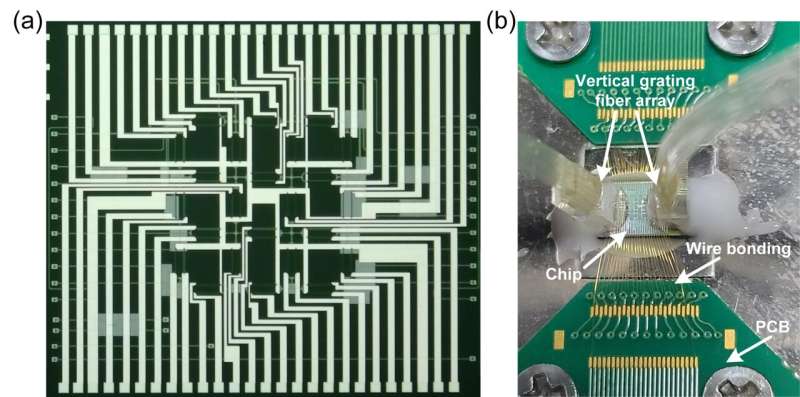This article has been reviewed according to Science X's editorial process and policies. Editors have highlighted the following attributes while ensuring the content's credibility:
fact-checked
peer-reviewed publication
trusted source
proofread
New easy-to-use optical chip can self-configure to perform various functions

Researchers have developed an easy-to-use optical chip that can configure itself to achieve various functions. The positive real-valued matrix computation they have achieved gives the chip the potential to be used in applications requiring optical neural networks. Optical neural networks can be used for a variety of data-heavy tasks such as image classification, gesture interpretation and speech recognition.
Photonic integrated circuits that can be reconfigured after manufacturing to perform different functions have been developed previously. However, they tend to be difficult to configure because the user needs to understand the internal structure and principles of the chip and individually adjust its basic units.
"Our new chip can be treated as a black box, meaning users don't need to understand its internal structure to change its function," said research team leader Jianji Dong from Huazhong University of Science and Technology in China. "They only need to set a training objective, and, with computer control, the chip will self-configure to achieve the desired functionality based on the input and output."
In the journal Optical Materials Express, the researchers describe their new chip, which is based on a network of waveguide-based optical components called Mach–Zehnder interferometers (MZIs) arranged in a quadrilateral pattern. The researchers showed that the chip can self-configure to perform optical routing, low-loss light energy splitting and the matrix computations used to create neural networks.
"In the future, we anticipate the realization of larger-scale on-chip programmable waveguide networks," said Dong. "With additional development, it may become possible to achieve optical functions comparable to those of field-programmable gate arrays (FPGAs)—electrical integrated circuits that can be reprogrammed to perform any desired application after they are manufactured."
Creating the programmable MZI network
The on-chip quadrilateral MZI network is potentially useful for applications involving optical neural networks, which are created from networks of interconnected nodes. To use an optical neural network effectively, the network must be trained with known data to determine the weights between each pair of nodes—a task that involves matrix multiplication.
"On-chip matrix operations have been typically implemented using forward-propagating MZI networks or microring arrays," said Dong. "Inspired by FPGAs in electronics, we wanted to use an MZI topological network structure that allowed both feedforward and feedbackward propagation for matrix operations."
The chip they developed can be reconfigured by adjusting the voltages of electrodes, which creates various light propagation paths in the quadrilateral network. The researchers integrated a gradient descent algorithm to accelerate the convergence rate of the cost function, which gauges the accuracy of the network with each training iteration.
After each training iteration, the chip updates the voltages of all the adjustable electrodes—rather than the value of a single variable—which further improves the convergence rate of cost function. These improvements help make the training process faster.
Achieving various functions
The researchers showed that the chip can be used to perform what is known as positive real matrix computation, verifying the feasibility of this in a quadrilateral MZI network for the first time. The error between the chip's training results and the target matrices was minimal.
They also demonstrated optical routing—a specialized case of positive real matrix computation—with a high extinction ratio. Optical routing can efficiently route optical signals between equipment, such as processors and memory units, in data centers. Compared to electrical counterparts, optical approaches help reduce latency and power consumption when processing a large number of signals.
Additionally, the chip was used for low-loss optical power splitting, which splits a single input light into beams that have proportional energy at its output port. Statistical analysis of the results from 11 test sets showed that the energy loss during splitting remained below 1.16 dB. Low-loss optical energy splitting can be used to send signals to different components on the chip such as processors and photodetectors. This facilitates the simultaneous processing of input signals.
The researchers are now working to make improvements to the chip that would allow even more matrix operation capabilities. They would also like to explore using it for other applications of matrix computing beyond optical neural networks.
More information: Mengyao Zhao et al, On-chip multifunctional self-configurable quadrilateral MZI network, Optical Materials Express (2023). DOI: 10.1364/OME.499408
Journal information: Optical Materials Express
Provided by Optica




















